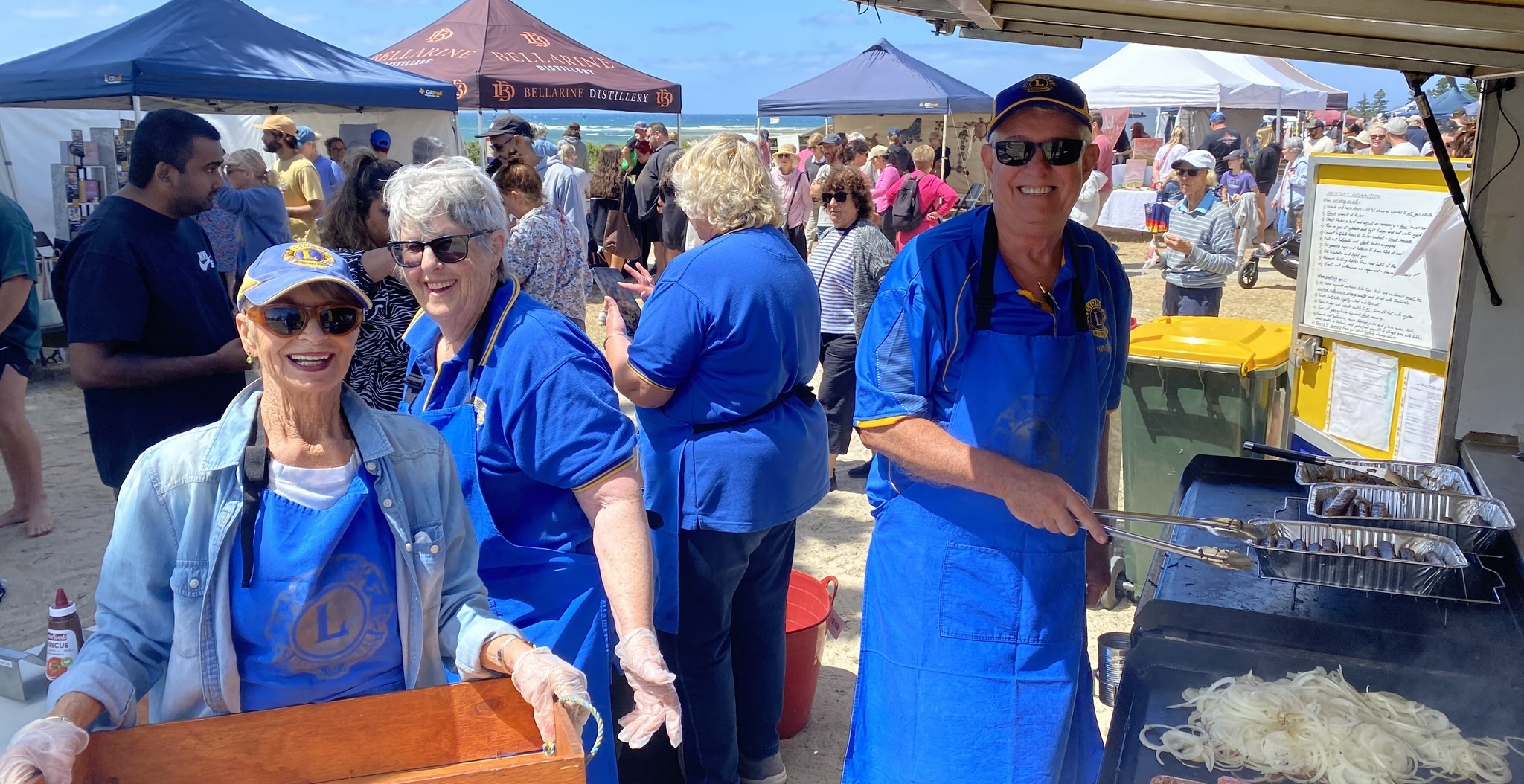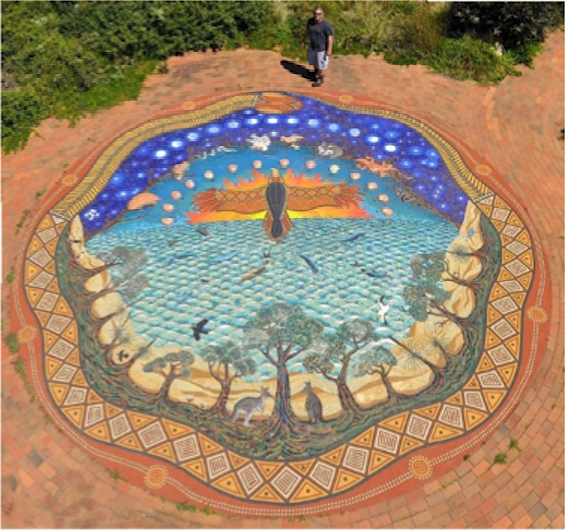Lions Club of Torquay
Victoria, Australia, District 201V2
we serve... service to the community... learning new skills... building lasting friendships...

Lions Sundial
Sundial of Human Involvement Torquay

A community project of the Lions Club of Torquay Inc.
Check out our website and Facebook page for contact details, membership enquiries and information about Lions and our Club’s varied activities.
Check out your local Lions Club too – they are all over the world!
TORQUAY’S SUNDIAL IS UNIQUE
The Sundial of Human Involvement (so-called because it relies on the shadow cast by a person) is situated on foreshore land at Fisherman’s beach, near where Deep Creek joins the sea.
Map showing location of sundial courtesy of Melbourne Playgrounds website
This is Wadawurrung Country. And close by (to the south and west) is the land of the Eastern Maar. The Torquay Sundial represents dreaming (traditional) stories including of Mindii the ever-watchful snake, his Dreaming Tracks and of Bunjil the Eagle, creator and overseer.
The Torquay sundial is assembled in a time-honoured method of mosaic using more than 120,000 glass Tesserae tiles, laid out on an eight-metre diameter concrete slab in a natural setting overlooking the ocean and coastline. The landscaping around the Torquay Sundial uses indigenous plants.
The central theme of the mosaic depicts moon phases, star constellations, the ocean, sand dunes and coastal Torquay, including its precious local flora and fauna.
Correctly known as an Analemmatic Sundial, it consists of a central analemma (part of the eagle) and hour markers (shells) in an elliptical pattern. A person standing on the analemma can tell the time from their shadow.
The sundial registers time in relation to the azimuth of the sun. (The azimuth is the angular distance on the horizon plane between the true north-south line and the foot of the perpendicular from the sun to horizon.)
The sundial was installed in 1996 – a community project of the Lions Club of Torquay. Lion Alan Young was a driving force behind the sundial.
The sundial was designed by local artists Claire Gittings (who has also spent many hours maintaining the installation) and Glenn Romanis. They were assisted by Anne Kalamaris, Kathryn Soanes, Mark Trinham, Kyla Beale and Steve Vinton to bring the design to reality.
The calculations, marking and orientation of the sundial were done by Ian Sells of Torquay.

HOW TO USE THE SUNDIAL
1. Stand on the body of the eagle (on the analemma), at the correct date.
2. Your shadow will indicate the time (but remember to add 1 hour during daylight savings time).
The central analemmatic curve is continuous and the person should stand at the point closest to the date. For example, if it is the end of April you should straddle a point corresponding to the end of April on the curve.
ABOUT SUNDIALS
During the day the sun appears to move across the sky, causing changes in the length and position of the shadow cast by any solid object (including you!). The height of the sun above the horizon also varies the position of the shadow.
For more than 5,000 years, people have used the movement of shadows produced by the sun for reckoning time and important days on the calendar.
A ‘sundial’ is any device which uses the length of a shadow or its angular position to divide the period between sunrise and sunset.
Not all types of sundials work equally well everywhere in the world. Conventional (horizontal) sundials like ours do not work well near the equator. There are also (vertical) sundials that can be attached to walls, but these are not accurate near the North and South Poles.
Other Analemmatic Sundials in Australia include those at Mount Annan Botanic Gardens in Sydney NSW, Sculpture Park in Kingston SE SA, Bowral NSW), Benalla VIC and Portland VIC.
TIME KEEPING ACCURACY
Any sundial that is properly designed for its location will tell time accurately for the next few centuries. The Torquay sundial is designed for its exact latitude (38° 19' 30" S) and longitude (144° 19' 45" E).
But before a sundial will indicate the same time as your watch or phone a few corrections to the shadow reading are needed.
The first correction is because the Earth’s orbit around the Sun is elliptical; therefore the Earth slows down when it is furthest away from the Sun and speeds up when it is nearest. Also the Earth’s axis is not perpendicular to its plane of orbit around the Sun. Together these effects are corrected by the ‘figure eight’ shape of the central analemma of the Torquay Sundial.
Another correction occurs because of the difference in time between the Sundial’s actual location and the local time zone longitude of 150° East, the reference point for Australian Eastern Standard Time. This correction is incorporated into the positions of the shell markers.
A further adjustment is required for Daylight Savings – add one hour to the indicated time.
INDIGENOUS HERITAGE
The Sundial depicts the story of MINDII. MINDII was a great snake – very long, very thick of body and very powerful.
When MINDII hissed he ejected poisons and his 3-pronged tongue appeared. He lived far away to the North-North-West. Death or disease would be the fate of any person who attempted to walk near MINDII’s home.
MINDII was believed to be under the domination of BUNJIL – the creator. MINDII had the power to extend or contract his size when BUNJIL ordered him to do BUNJIL’s work. He could extend to reach any mob. A visit from MINDII was dreaded – from him rarely anyone could escape!
If MINDII was known to be about, people set fire to the bush and fled. Some perished while fleeing. Those who could run fast enough could reach the ancient sorcerer MOONI-BROOM-BROOM who had the power to make MINDII return to his home.
Can you see MINDII (the snake) and BUNJIL (the eagle) in the Sundial?
STARS and CONSTELLATIONS
The stars and constellations in the Sundial (left to right), using their aboriginal words from the Wadawurrung language (where available), are:
• Worrul meaning bees’ nest. (Pleiades - commonly known as ‘the seven sisters.’)
• Bunjil is the wedge-tailed eagle. (Formalhaut is the brightest star in this formation.)
• (Sirius – this single star is the brightest star in the sky.)
• Teer:Rer meaning spear. (Part of the constellation Centaurus. These 2 bright stars are commonly called ‘the Pointers’ as they point towards the Southern Cross.)
• Ngu:oo or Woo:Lerp meaning tea tree. (Crux - Commonly known as the Southern Cross, this constellation is always visible on a clear night from our latitude.
• (Part of the constellation of Orion - ‘the hunter’. Commonly called ‘the pot’ - formed by the belt and sword of Orion).
• Waram:Bool means a roadway lined with trees – a promenade of the dead. (Commonly called ‘the Milky Way’, this is a galaxy composed of thousands of millions of stars, including our sun.)
WHAT ELSE CAN YOU SEE AROUND US?
The beach closest to the Sundial is known as Fisherman’s Beach, and you can see the entrance to Deep Creek (which is actually very shallow here and is often closed from the sea other than when rainfall has been especially heavy).
Looking to the south you can see Point Danger and (closer to the Sundial) the headland near town. ‘Cosy Corner’ is this side of Point Danger; the surf beach is on the other side.
Looking the other way (north east) along the coast, you can see White’s Beach which leads up to Point Impossible. The big bluff (on compass bearing 65°) is at Barwon Heads. Further along, on a clear day you can see the lighthouse at Point Lonsdale.
Looking out across the water (almost due east) you may see a large mountain – Arthur’s Seat (on the Mornington Peninsula). In between are the towns of Portsea and Sorrento.
For more information on Torquay and the Surf Coast, visit the Torquay Visitor Information Centre, Beach Road Torquay (located with the Australian National Surfing Museum).
The Lions Club of Torquay acknowledges the Wadawurrung community as the traditional owners of the land on which we meet. We pay our respect to their elders past and present.